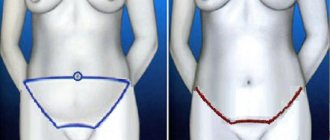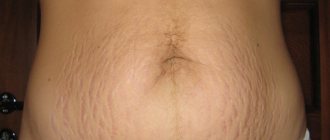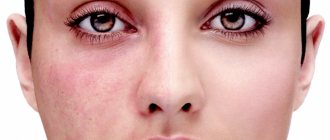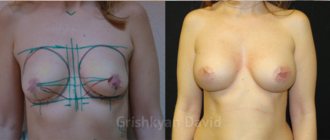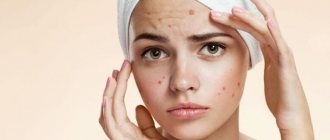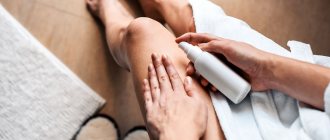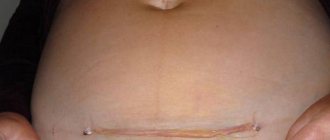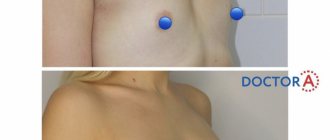Pregnancy becomes a whole challenge for women, regardless of their age and health status. At this time, a complete restructuring of the body is underway, changes affect both the internal organ systems and the emotional state, and the hormonal system is affected. An increase in blood volume and fetal pressure on internal organs entails additional stress on the heart muscle. This disrupts blood circulation. The most serious impact is observed in the third trimester, when the fetus rapidly gains weight. As a result of this load, varicose veins often occur. The first sign is the appearance of spider veins on the skin. Capillaries overflowing with blood begin to appear through the skin. Removing spider veins will help cope with this problem . Most often, the mesh covers the abdominal area, the outer surface of the thighs and lower legs. The medical definition of these formations is telangiectasia .
What do spider veins look like?
As a rule, the mesh that forms on the skin has a lilac or bluish color. It can appear as barely noticeable veins, dots or a whole web. Depending on the degree of vascular damage, there are four types of this disease:
- Dot grid. Most often localized in the abdominal area. These may just be red dots, or there may be small spots in the form of stars.
- Linear grid. It looks like several independent distinct lines, most often in the abdominal area.
- Cobweb. In this case, several lines of translucent capillaries form an entire network that looks like a spider's web. Such plexuses of vessels usually have a diameter of about five centimeters. Most often, cobwebs appear on the legs.
- Wood mesh. Translucent capillaries are a tree-shaped plexus. As a rule, it is located on the legs; such manifestations do not occur on the stomach.
Stages of the disease
Cuperosis is divided into 4 stages, each of which is characterized by its own specific symptoms in the form of tingling, burning or obsessive itching:
| Stages of the disease | ||
| Stage | Description | Photos at various stages of pathology |
| First | The first stage of the disease is characterized by mild “hot flashes” of some areas on the skin, which occur for no apparent reason. Afterwards, the redness gradually decreases, gradually disappearing completely. The condition of the vessels at this stage is acceptable and they still have sufficient elasticity and are able to contract. |
|
| Second | The second stage of the pathology is the appearance of a spider vein. This occurs due to the capillaries losing their elasticity. They can no longer contract and become visible through thinning skin. At this stage, women most often seek cosmetic help from a specialist. |
|
| Third | The third stage of the disease is characterized by the occurrence of localized circulatory disorders of a chronic nature. For this reason, there is a significant lack of nutrients in the skin. The damaged areas can sometimes become inflamed. |
|
| Fourth stage | The fourth stage of pathology is characterized by the fact that the skin becomes dry and extremely thin. Peeling zones appear on them. Redness is replaced by excessive pallor with a grayish tint. The capillary network, visible through the skin, acquires a blue-purple color. |
|
Causes of spider veins during pregnancy
The reason for the appearance of varicose veins on the skin of a pregnant woman lies primarily in hormonal changes. Starting from the earliest stages, the level of estrogen in a woman’s body increases, which entails changes in the walls of blood vessels. Capillaries located close to the surface of the skin begin to swell and become translucent.
If there are no pathologies in the woman’s history, telangiectasia after childbirth will gradually disappear on its own. If there are diseases of the liver, pituitary gland or ovaries, then varicose veins will require special treatment, namely removal of spider veins . Also, removal of the spider veins will be required if the woman has a hereditary predisposition to venous diseases.
In addition to the influence of estrogen, changes in the cardiovascular system contribute to the appearance of spider veins The volume of circulating blood increases, the heart does not cope well with the increased load, and the blood circulation rate decreases. The level of blood circulation in the leg area suffers the most. The pressure on the veins becomes very strong, which leads to varicose veins.
Cuperosis during gestation and after delivery
Pathology is formed as a result of various factors, one of them is hormonal changes in the body, during which a violation of the hormonal ratio occurs. Hormonal changes can occur due to physiological changes in the body of a woman bearing a child. Due to such changes, the tone of the vascular walls decreases and capillaries expand.
How to cope with pronounced vascular network on the face.
The video in this article will introduce patients to the main reasons for the appearance of so-called stars on the face after childbirth.
“Stars” of blood vessels mostly appear on the face; they can be located in the following areas:
- frontal part;
- wings of the nose;
- chin;
- cheeks.
Symptoms of rosacea occur due to stagnation of blood, which accumulates in the capillaries and leads to their expansion.
When there is no adequate treatment for the pathology, it progresses - the load on the capillaries increases, thereby reducing their elasticity. For this reason, the vascular network begins to be visible under the skin.
Attention! The main cause of pathology after childbirth is pronounced stress during the delivery process.
How to endure the pushing process without injury.
Sometimes blood vessels on the face burst due to the stress experienced by a woman during childbirth. Couperosis is often a consequence of a woman’s incorrect behavior during the pushing period - the woman in labor did not push according to the advice of specialists, but directed the main effort “in the face.” The capillaries could not withstand such pressure and burst due to intense stress.
In addition, the disease can be provoked by some other negative factors:
- frequent stressful situations;
- genetic predisposition:
- excessive amounts of spicy and spicy foods in the diet;
- smoking, consumption of alcohol-containing products;
- menopause period;
- aggressive cosmetic procedures;
- heavy physical activity.
In addition to the above, rosacea develops as a result of sudden temperature changes, when the vessels do not have time to adapt to the environment and are damaged. Also, the occurrence of pathology can be caused by excessive UV radiation.
A genetic factor should not be ruled out.
Any manipulations aimed at getting rid of rosacea are strictly prohibited in the 1st trimester of pregnancy. Only after the 13th week of gestation, when all the structures of the fetal body have already been formed, is medication or surgical intervention allowed.
However, only a doctor can determine the advisability of using certain methods. However, to carry out therapy, it is advisable to obtain permission from the doctor managing the pregnancy.
There may be contraindications to any measures or the use of certain groups of medications due to the incommensurability of the positive effects and possible harm to the fetus.
It is important to consider that the price of laser correction is quite high and this process is not always safe.
Is spider vein removal allowed during pregnancy?
spider veins and spider veins that appear during pregnancy do not pose any threat to the body, removal of spider veins on the legs or other areas before childbirth is not recommended. Moreover, most often such manifestations resolve on their own within a short period of time after childbirth. It is advisable to seek medical help only if the defect does not disappear over time or continues to progress.
What is the treatment for varicose veins after childbirth?
Modern treatment of varicose veins after childbirth is practically no different from the treatment of varicose veins in other situations. The only important difference is some time restrictions inherent in the postpartum period. Most often, radical treatment of varicose veins begins six months after childbirth. It includes the following components:
- Endovascular thermal ablation (laser or radiofrequency).
- Miniphlebectomy.
- Scleroobliteration.
These modern technologies make it possible to treat varicose veins after childbirth quickly and radically. To treat varicose veins after childbirth using the most effective and modern techniques, you need to choose the clinic and doctor wisely.
Treatment of varicose veins after childbirth in our clinic
The specialists of the Innovative Phlebological Center have significant experience and use the most current technologies for the treatment of varicose veins in their practice, which allows them to treat varicose veins after childbirth in the shortest possible time without side effects and strict restrictions.
Removal of spider veins using neodymium laser Quanta System
The most popular method of getting rid of varicose veins is laser removal of spider veins with a Quanta System neodymium laser. The demand for this procedure is due to its painlessness and speed.
When using a laser, a positive result is achieved regardless of the area and degree of damage to the skin.
Questions about how and when it is best to treat varicose veins after childbirth
When is the best time to treat varicose veins after childbirth?
It is necessary to begin treating varicose veins after childbirth immediately after diagnosis. Compression hosiery, adherence to the regimen, all this is necessary to prevent complications of varicose veins. Radical treatment of varicose veins can be performed only a few months after childbirth.
What methods are used to treat varicose veins after childbirth?
To treat varicose veins after childbirth, the same techniques are used as in other situations. Modern mini-invasive technologies are universal. For the treatment of varicose veins after childbirth, the following are used: endovasal laser coagulation, radiofrequency obliteration, obliteration, miniphlebectomy and scleroobliteration.
When should you see a doctor after childbirth if varicose veins appear?
If varicose veins appear after childbirth, you should consult a doctor immediately. Inaction and failure to comply with certain prevention principles can lead to the development of complications of varicose veins of the lower extremities.
What is the best treatment for varicose veins after childbirth?
The most optimal treatment for varicose veins after childbirth will be modern endovascular intervention, effective and safe.
Laser operating principle
When exposed to laser beams, the affected capillaries are destroyed without causing damage to healthy tissue. This effect can be achieved due to the reduced hemoglobin content in diseased capillaries. Healthy vessels are not exposed to laser waves, because they are absorbed by hemoglobin. The skin is also not exposed to the radiation, which is absorbed in this case by melanin. Thus, the laser action is aimed only at dilated and damaged capillaries. The appearance of burns and scars when removing blood vessels with a laser is also excluded, since continuous cooling of the skin is provided.
Nutritional Features
What foods should form the basis of your diet?
When a woman bursts blood vessels on her face while carrying a child or after childbirth, she needs to follow a certain diet. This diet involves eating foods that do not harm the cardiovascular system and strengthen the body as a whole.
Proper nutrition for rosacea consists of eating food that is high in vitamins.
The main products that should be included in your diet are the following:
- red paprika;
- carrot;
- buckwheat;
- parsley;
- asparagus.
The listed products are characterized by high concentrations of rutin. You should also include spinach as it contains large amounts of vitamin K, which improves vascular strength.
To get enough vitamin C into your body, you need to consume the following categories of foods:
- cabbage;
- citrus;
- onion;
- currants
The benefits of ascorbic acid.
Ascorbic acid normalizes blood circulation and causes blood vessels to become less fragile. You also need to consume sufficient amounts of calciferol, which is found in dairy products. We must not forget about Omega-3 fatty acids, the record holder of which is sea fish.
Attention! Proper nutrition can somewhat speed up the healing process.
Basic nutritional recommendations:
- The presented products are recommended to be consumed boiled, baked, stewed or fresh.
- It is required to strictly follow the drinking regime - to restore water balance, you need to consume at least 1.5 liters of purified water per day.
- It is necessary to completely stop consuming tonic drinks and carbonated drinks.
- Reduce consumption of excessively salty, hot and spicy foods.
- Completely avoid fried and smoked foods.
- Stop smoking and consuming alcohol-containing products.
By reviewing your own eating habits, you can significantly improve your condition and reduce the signs of rosacea.
How does the procedure work?
Before removing blood vessels using a laser, the skin is treated with a solution, then a special gel is applied. When eliminating defects on the face, the patient wears glasses that protect the eyes from the laser flash. There is no pain during laser exposure; only minor tingling sensations can cause discomfort. The use of anesthesia is indicated only in case of serious damage to large vessels.
Removal of spider veins in time depends on the degree of damage to the vascular tissue and the individual characteristics of the venous system. To remove a formation of small diameter (1-1.5 cm) it will take only a couple of sessions. To eliminate larger defects, three to five sessions are needed.
How does the symptom appear?
For reference! A burst vessel represents a hemorrhage under the skin, therefore, small bruises will be visible on the skin under the eye.
If several nearby vessels burst at once, the bruise may take the form of a bruise .
There are no painful sensations , swelling or other symptoms either .
With a bruise resulting from a blow, there will of course be pain.
However, it is associated not so much with a burst vessel, but with soft tissue swelling.
If bruises under the eyes are associated with pathological processes in the liver , then the symptoms may be as follows:
- dyspeptic disorders;
- skin itching;
- yellowness of the skin.
In diseases of the endocrine system , bruising under the eyes is accompanied by:
- low pressure;
- dry skin;
- digestive disorders.
Note! If the hematoma is red in color, the vessel may have burst as a result of allergic reactions or problems in the genitourinary system. Couperosis is also possible.
If a yellow tint , the causes most likely lie in problems with the liver or blood.
The purple color of the bruise indicates oxygen starvation; pulmonary diseases or anemia are possible.
With
a black bruise, excess melanin can be assumed.
Rehabilitation period
After laser intervention, it takes time for the skin tissue to recover. During this period, it is recommended to observe the following rules:
- For three days, avoid contact with water and alcohol solutions of the treated skin area;
- The crust formed after the operation must not be removed or scratched;
- In order to accelerate regeneration, it is recommended to use panthenol ointment or cream;
- For a month after the operation, visiting baths and saunas is prohibited;
- Avoid direct sun exposure to the area undergoing the procedure for a year. Be sure to use sunscreen.
Preventive actions
Remember! To ensure that the vessels are strong and their walls do not lose their elasticity, it is necessary to adhere to the following preventive measures:
- more time in the fresh air ;
- review your diet ;
- get a full night's rest ;
- take proper care of your facial skin;
- protect the skin around the eyes from the negative effects of sunlight;
- reduce stress;
- get rid of bad habits.
The preventative effect will be stronger if you add eye exercises, lotions, masks, etc. to the above.
Contraindications to laser removal of blood vessels
Despite the fact that removing spider veins with a laser does not cause any harm, there are limitations to the use of a neodymium laser:
- chronic diseases, oncology;
- connective tissue pathologies;
- inflammation and skin diseases;
- acute viral infections;
- epilepsy;
- the period of gestation and the period of breastfeeding;
- medicinal effects that increase the photosensitivity of the skin;
- exposure of the skin to high temperatures or chemical compounds less than 10 days before the session.
Removing broken capillaries on the face
In response to the question of what to do if capillaries burst, most experts advise resorting to laser exposure or undergoing a course of mesotherapy. These techniques are universal and effective, and at the same time have a number of positive properties for the skin.
Laser removal
Laser treatment allows you to eliminate small capillaries in just one session. The beam energy acts on the injured vessel without damaging the surrounding tissue, so the procedure is absolutely safe.
Laser removal of capillaries is carried out as follows:
- The cosmetologist cleans the client’s face, puts on protective glasses, and applies a special gel to the treatment area. This minimizes discomfort and also protects against burns.
- After setting up the device, laser coagulation is performed.
- At the end of the session, a protective agent is applied, and the patient is given recommendations regarding the recovery period after the procedure.
In total, the session usually takes no more than half an hour. After it, for 2-3 weeks it is important to carefully protect the skin from exposure to ultraviolet radiation and temperature changes. Among the contraindications to laser coagulation of blood vessels:
- diabetes;
- neoplasms;
- acute diseases with skin manifestations;
- period of pregnancy and breastfeeding.
Removing spider veins using mesotherapy
The procedure for removing spider veins using mesotherapy is based on the direct effect of medications on the affected vessels. A small dose of medication is injected into the top or middle layer of the skin.
When treating stars and meshes, the doctor administers multiple injections of hyaluronic acid and vitamins. Under the influence of the drug, not only defects disappear, but also the elasticity of the skin increases and blood circulation improves.
The duration of one session is half an hour. Usually 5-10 sessions of meso-cocktails are required with an interval of 1-2 weeks.
Prevention of ruptured blood vessels
To reduce the likelihood that you will one day experience the problem of a red eye due to a burst blood vessel, you can take the following preventive measures:
- Try to avoid increased physical activity. If you are involved in sports or fitness, follow the recommendations of your trainer or instructor to avoid overexertion.
- Monitor your health and promptly treat diseases that may result in bleeding in the eye.
More attention should be paid to nutrition. Many foods contain vitamins that can improve blood circulation in the eyes. It is especially important to consume foods that contain vitamins P. In combination with ascorbic acid (vitamin C), they can reduce the permeability and fragility of blood vessels and improve their elasticity. Such vitamins are found, for example, in apricots, cherries, rose hips, tomatoes, and raspberries. They are also available in dark chocolate with a cocoa content of at least 75%. If for some reason you do not have the opportunity or desire to include these products in your diet, you can use special vitamin complexes for the eyes. There are also vitamin drops that contain substances that strengthen the blood vessels of the eyes.
